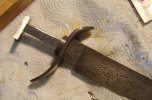Actually, those answers suck!!!

Just kidding

I agree with the guys
completely.
BUT! Let me throw a wrinkle in there.
I used to do pommels with blind holes and used bottoming taps.
The problem that can POSSIBLEY arise, is you often have to use a fairly thick, almost (sometimes VERY) clunky looking pommel. I'm not saying that's a given... as you really only need a couple/few turns on the threads.
You can use REALLY thin OR thick material (if you wish) by welding or soldering a stand-off to the pommel material.
I buy them from K&G, but you can get them from places like McMaster Carr.
Since a picture is worth a thousand words---
And here's an example of how you can do a thin, domed pommel with this approach. The 416 for these pommels started off as 1/8" but was then domed, so it's quite thin. However, because of the stand-offs, there is about 1/2" of threaded sleeve wrapped around the tang, up inside the handle.
Hope this helps Michael

-Nick-




